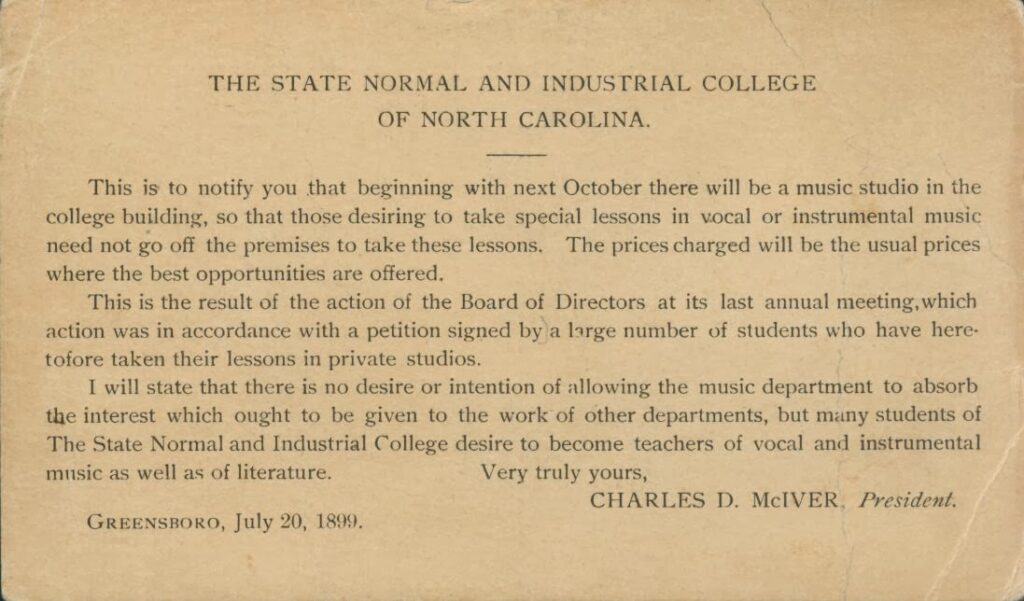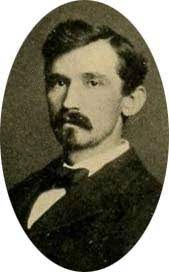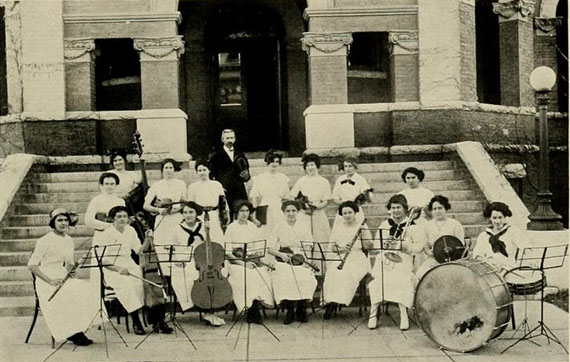While the founders of the State Normal and Industrial School agreed that some music education was critical to a woman’s education, the first fifteen years of the School’s history were spent puzzling over why and how to fit music into the curriculum rather than developing a music curriculum. As the School was founded with the mission of producing teachers and educated mothers to assist in the recovery of the post war South, classes needed to support the three concentrations of study: Normal, Industrial, and Commercial. Consequently, what would become the early Music Department (beginning 1907-08) was built from two separate music departments, the Department of Vocal Culture and the Department of Instrumental Music. These two programs operated parallel to each other, formed by differing needs and influences.
When the Prospectus for the State Normal and Industrial School was published in 1892, the “music program” was part of the Department of Vocal Culture, listing Bessie Worthington as the instructor. By the time the first class of students arrived on campus, the instructor position for the department had been transferred to Clarence Richard Brown, a music teacher from Winston, North Carolina. Brown, with Lina McDonald as his assistant, constituted the first music faculty on campus. However, Vocal Music was only one part of the Department of Vocal Culture, which also included Reading and Elocution. Vocal music comprised the entirety of the music curriculum until 1899. The Department of Vocal Culture was categorized as a Special Department, meaning that requirements for the courses would be specific to certain concentrations of study.

In the Third Annual Catalog , courses in music were most emphasized in the Normal (listed as “regular” in the catalog) and Commercial curricula. Classes in Vocal Music were required for freshman and sophomores, but transitioned to Elocution for juniors. None of the three concentrations of study required classes in Vocal Culture by the senior year. Examinations for these classes were divided into theory and practice by 1897, and particularly talented freshmen could transfer to or place out of required classes after a three month review.
The rationale for requiring classes in vocal music for all students derived from the leadership roles available to women at that time. Singing and teaching others to sing served as a necessary skill set for women in secular and religious organizations. The rationale for requiring classes in vocal music for all students derived from the leadership roles available to women at that time. Singing and teaching others to sing served as a necessary skill set for women in secular and religious organizations. By the 1894-95 school year, when Vocal Music was listed in the course catalog as an official department, the mission of the department was:
“To give each student, regardless of any special talent for music, an opportunity to become a fairly good singer, to have sufficient knowledge in the rudiments of music to enable her to read at sight all ordinary music, and to be able to teach the first principles of singing and sight-reading to the pupils of her school.”
Predictably, the first music classes at the State Normal and Industrial School aimed at music education, reflecting the overall mission of the School—to produce competent educators. Because of the narrowness of the pedagogical focus on music and the democratic view that all students “regardless of any special talent for music” should be taught, demand was made for more extensive and exclusive training by the more musically inclined students.
In 1899, Dr. McIver and the Board of Directors approved the creation of the Special Department of Instrumental Music, under the leadership of Charles J. Brockmann and Laura Brockmann. Although classes in this department were open to any student, an extra $40.00 in fees had to be paid for lessons in this program. The Brockmanns had been operating a private music school on West Market Street, providing instruction for piano and stringed instruments, their students commonly serving as the orchestra for School functions.
Although the Brockmanns offered training in a variety of instruments, only piano and violin counted in terms of grading (with the exception of a rouge mandolin performer mentioned in the 1903 course grades). The course of study was more rigorous than that of Vocal Music, two years work in harmony, one year in music history (taught by Clarence R. Brown), and one or more years in ensemble performance. Entrance requirements for the “Music Course,” a course designed for skilled musicians, demanded that the student demonstrate “sufficient training to play the simple forms of scales in all keys correctly, and to read music in the easier grades readily at sight.” By the 1900-01, the School Orchestra was formed and in the 1902 semester, nearly fifty students had enrolled to take classes in instrumental music.
Although Vocal Music and Instrumental Music were separate departments as of 1902, the School had implemented a more robust music curriculum overall. In this year, the first diploma in music was offered, specifically for vocal music, pianoforte, and violin. This diploma was not an actual degree in music, serving more as a certification designating a course of study with a music concentration. The first student to earn this diploma was May Lovelace, who taught music at the Graded School in Wilson after graduation. The first senior essay devoted to music, “Influence of Music,” was written in 1902 by Ella Louise Mallison.
The 1907-08 school year was pivotal for the music program, as the program experienced substantial changes in terms of staffing and structure. After Clarence R. Brown’s death in 1907, Hermann H. Hoexter served as head of Vocal Music. Additionally, Albert S. Hill was hired as Director of Music, combining the Departments of Vocal Music and Instrumental Music into a single unit. With the unification of the music program, the first course of study leading to a Bachelor of Music was offered. The Department of Music continued to grow, in terms of faculty and courses offered, but would experience a massive transformation under the leadership of Wade R. Brown in 1912.
This is part two of a series of posts chronicling the history of music program at UNCG. Part 1 on the funding of the music program can be found here.
Article by Stacey Krim




One reply on “Music on Demand, Part 2: Music and the Early Curriculum, 1892-1910”
[…] This is part one of a series of posts chronicling the history of music programs at UNCG. Part 2 can be found here. […]